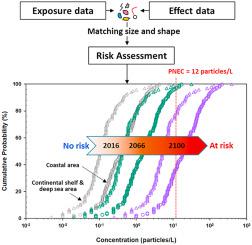Environmental Pollution ( IF 7.6 ) Pub Date : 2020-12-02 , DOI: 10.1016/j.envpol.2020.116217 Jae-Woong Jung , June-Woo Park , Soeun Eo , Jinsoo Choi , Young Kyoung Song , Youna Cho , Sang Hee Hong , Won Joon Shim

|
This study assessed the ecological risk posed by microplastics in surface and subsurface seawaters in coastal, continental shelf, and deep-sea areas of South Korea. The target microplastics for risk assessment were specified as only non-spherical type microplastics in the size range 20–300 μm, because this type was predominantly observed in our study areas, and adverse biological effects have previously been reported. Exposure data for non-spherical microplastics were obtained from a previous study or were measured for microplastics of sizes down to 20 μm. A predicted no-effect concentration (PNEC) of 12 particles/L was derived by employing a species sensitivity distribution approach. Then the results were compared to the in situ observed concentrations at each site. The detected microplastic concentrations did not exceed the derived PNEC, i.e., the current pollution levels of fragment and fiber microplastics in the size range 20–300 μm would not pose a significant threat to the marine ecosystem in South Korea. However, predictions are that microplastic pollution will increase to 50-fold by 2100 at the current rates, and in this scenario, the microplastic concentration is expected to far exceed the derived PNEC values for marine ecosystems. It is therefore urgent to take precautionary actions to prevent a further increase in microplastic concentrations in these environments.
中文翻译:

考虑到与环境有关的大小和形状,对沿海,陆架和深海中的微塑料进行生态风险评估
这项研究评估了韩国沿海,大陆架和深海地区地表和地下海水中微塑料所带来的生态风险。风险评估的目标塑料仅指定为尺寸范围为20-300μm的非球形微塑料,因为这种类型的塑料主要在我们的研究区域中观察到,并且先前已经报道了不利的生物学影响。非球形微塑料的暴露数据是从先前的研究中获得的,或针对尺寸低至20μm的微塑料进行了测量。通过采用物种敏感度分布方法得出了12个颗粒/升的预测无效应浓度(PNEC)。然后将结果与原位进行比较在每个站点观察到的浓度。检测到的微塑料浓度不超过派生的PNEC,即,当前碎片和纤维微塑料的污染水平在20-300μm范围内不会对韩国的海洋生态系统构成重大威胁。但是,据预测,以目前的速度,到2100年,微塑料污染将增加到50倍,在这种情况下,微塑料浓度预计将大大超过海洋生态系统的PNEC值。因此,迫切需要采取预防措施,以防止这些环境中的微量塑料浓度进一步增加。











































 京公网安备 11010802027423号
京公网安备 11010802027423号